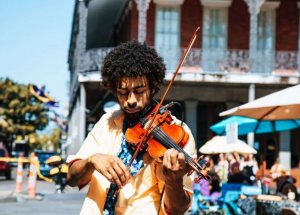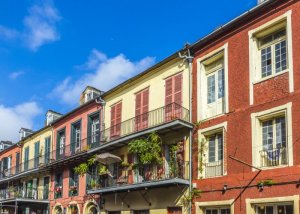The Courts are Home Again on Royal Street
It took two years to build and two decades to renovate. To some it was an elegant City Beautiful triumph of slum clearance, to others an out-of-scale offense to an historic neighborhood. Home to landmark legal decisions and antique documents, it gave way to stuffed birds, mounted fish and rock displays. Increasingly beleaguered, empty and abandoned, it fell “tumbling into ruin.” Proposed as an opera house, casino parlor, tourist center, movie set, or better yet, for demolition, it soon housed live birds and real animals, nesting in the nooks of its ornate spaces. But now–with restoration costs approaching forty million – the “New Court House” on Royal St. is new again.
New in 1910, abandoned in 1958 for more modern quarters
Opening in 1910, it was the “New Courthouse Building” for most of its life in the rousing world of jurisprudence. Its purpose was to “clear slums” while replacing the Cabildo and Presbytere as the seat of local justice. For fifty years the Louisiana Supreme Court and a spate of lower courts and offices drew swarms of glad-handed politicians, judges and lawyers, plaintiffs and defendants, juries and commissioners, clerks and secretaries, librarians, and even an occasional historian through its sculpted hallways. But in 1958 the Supreme Court departed for newer quarters and others soon followed. The halls that had rung with homegrown political wisdom, argument and judgment, now fell silent.
But today the courts are home again. Marble floors gleam again, plastered walls are clean again, and tech-savvy secretaries have settled in the nooks of its cavernous and newly scrubbed spaces. Meanwhile, residents, glad to see the courthouse live again, remember what was lost to history to accommodate its construction.
Built on two squares heavy with history
In 1831 the fourth block of Exchange Alley cut the site into two small squares with numerous stores and houses. A trim row of granite-columned stores lined the Alley from Canal to St. Louis Street. Cafés, studios, and the offices of architects and surveyors filled the row with conversation, art and engineering. At the end of the last block, facing the St. Louis Hotel, once stood the storied “Café des Colonnes,” planned by the talented architect de Pouilly. On Royal St. the “Grand Old Creole” Bernard Marigny had the polished Henry S. Bonneval Latrobe design a pair of elegant houses. On the same block General Jackson met with advisors to plan the Battle of New Orleans. Here later was the home of Mollie Moore Davis, wife of the Confederate president.
By the turn of the twentieth century this was all ancient history. To the business class, the deteriorated Quarter was a hopeless slum in need of general razing. Meanwhile, the political class saw the dawn of a new day in the demolitions needed for the brand new courthouse. But even with a blank slate, architects Brown, Brown and Marya faced a challenge in the heart of the Quarter. The Court’s mass and pristine white Beaux Arts exterior would contrast sharply with the small-scale buildings and unpainted surfaces around it. The complex building footprint they designed addressed this issue by diminishing the mass and allowing for considerable buffering in the landscaping. In plan, a rectangle on the Royal Street side diminishes to a narrower passage, and then spreads out expansively as it approaches Chartres Street, its arms ending in graceful semi-circular apses.
Overall, the Supreme Court has been a friend to the Quarter. Its findings in landmark cases like Mayer and Pergament have confirmed the regulatory power of the Vieux Carré Commission repeatedly. With the Courts now home again, judges will see first hand what coming years will plead for in the Old French Quarter.
Sally Reeves is a noted writer and historian who co-authored the award winning series New Orleans Architecture. She also has written Jacques-Felix Lelièvre’s New Louisiana Gardener and Grand Isle of the Gulf – An Early History. She is currently working on a social and architectural history of New Orleans public markets and on a book on the contributions of free persons of color to vernacular architecture in antebellum New Orleans.






